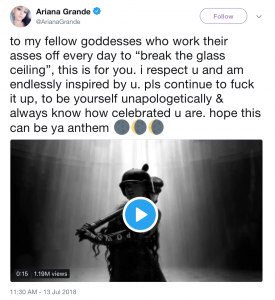The Cloverfield Paradox is a movie that’s part of a popular movie franchise of the same name, and is a prime example of media stickiness. The movie wasn’t advertised at all until the day of its release, on February 4th of this year. The announcement occurred during the Super Bowl LII advertisements, with the real surprise being the release date: The movie would be made available to stream on Netflix immediately after the Super Bowl ended. Sure enough, the viewer count was high for the week, stretching to just under four million views. The movie was a certain success when it came to sheer view count, and attracted fair numbers. However, the movie became a subject of controversy when it was revealed that it was not originally meant to be part of the series, and the scenes that connected it to the franchise were added in post production. In essence, it was only a “Cloverfield” movie due to some stapled on footage. Leading back into stickiness, the production company depended on the single form of communication (the Super Bowl broadcast) to garner attention and interest. The consumer experience was carefully produced, and designed to give a unified view of the product at hand. While news of the movie spread throughout other platforms, the only direct effort by the film team was the single Super Bowl spot. If you view it in the context of spreadability and stickiness, it leans much heavier on the latter, because it did not need the former in any way. Getting a spot on the Super Bowl was all the production company needed to do to get clicks and views. If they had advertised it months before release or made regular trailers, the cracks in the film’s appearance would have become much clearer to general audiences, more so to hardcore fans. In this case, less proved to be much more. Without the total control of how the film was marketed, the film would have flopped. Even though it was panned critically, film quality was never the goal. Attention and views were, and that goal was passed with certainty.
Monthly Archives: October 2018
Blog Assignment
Today i am going to discuss a famous singer in western countries he named Justin
Bieber. He is a very classic example who through the media can be a successful man in
our real world. Justin Bieber is a famous Canadian singer, he was born in March 1 ,
1994, when time turned to 2008 , initially he was cover version songs in youtube and
talent noticed him and in 2009 he released his debut album . I want to say in this case
we can see the media how to spreadability and stickiness and then quickly the youtube
had the millions of hits which is really fantastic because finally he was be a superstar
In the world. When he as a novice man the most of the teenagers likes her song
especially the girls when his age get older his amazing voice had recognition and
recognition and conviction of more people . His very familiar with song for having heard
In many times, such as “ What do you mean “ “ Sorry” “ Love Yourself” “ Despacito”
which a nice song and also I want to say is if the media does not spread just through
the traditional way and how could be so successful . It can related to Jenkins et al’s
notion of spreadability and Gladwell’s notion of stickiness . The reason why i
say that because the media’s spread create a superstar, if those new media
do not appear , Justin Bieber is really hard can be a superstar because
the traditional media restrict potential of social development , and also the
Justin Bieber’s situation is same like Susan Boyle. I learn from Jenkins is we
can not neglect the media’s effect , the media is always spread and the
Will never die because it connected with everybody’s life , because the
media is an uncrowned king a journalist, no matter who you are and what
Are you doing, it is the media’s spread impact and finally I want to say is I
hope the audience will like my work and I enjoy participatory culture.
When we walk in participatory culture and finally we will know is how
media strong related to our life.
PewDiePie: A Media Marvel
Felix Kjellberg, a 28 year old YouTuber known online as PewDiePie, has long been an outlier in the world of media. Since 2013, Felix has been the platform’s most subscribed content creator. Along the way, he never stayed with the same format. He started by uploading his first person shooter gameplay. However, he later evolved into the comedy genre when he started uploading gameplay of horror games. Recently, for the most part, Felix has shifted away from gaming. Now more focused on comedy commentary, he has since entered arguably his most successful stage. While most content creators tend to cater towards their demographics, following a very strict professional protocol, Felix has abandoned this protocol for the most part. This fresh indifferent attitude towards his popularity has lead to his continued growth.
This “protocol” can be seen as Malcolm Gladwell’s notion of stickiness as mentioned by Henry Jenkins. Stickiness is the focus on creating content that is proven to attract the current viewership, with the hopes that deep audience engagement will lead to eventual spread. With Felix shifting away from this model he can be seen as trending towards another concept brought up by Jenkins, spreadability. Spreadability, although not an opposite to stickiness, is a model which attempts to capitalize where the stickiness model lacks. Spreadable media concerns itself with creating content that is easily shareable by the audience, in both the technical and cultural sense.
Felix seems to break every rule when it comes to sticky media. He often shifts his content after building an audience accustom to a very specific subject matter. This content change allows him to be more spreadable in terms of exposure to different online cultures. Anytime that Felix follows the stickiness model it tends to be done in a parody-like way. One proven way that someone can boost their revenue on YouTube is by extending their videos past 10 minutes long. This method of gaining ad revenue closely follows the stickiness model. Through making a video longer it, by nature, relies on deeper engagement, not shareability. Felix has also adopted making videos past 10 minutes long. However, through the self-aware ironic tone he does this with, him appeasing to the stickiness model becomes the underlying joke.
Despite fighting against the stickiness model which is becoming so prevalent in the YouTube industry, Felix himself still relies on it. What makes Felix so popular is his near cult following. Having such a following heavily relies on deepening audience engagement. He does this through creating inside jokes and by encouraging his fans to post submissions he will respond to. It is through this blend of spreadable content with an underlying stickiness model that makes Felix the online enigma that he is.
Harry Potter— The Phenomenon That Never Dies
The phenomenon of Harry Potter has lasted long past its day. Last weekend I attended my little cousin’s birthday party and I was shocked to see my favourite childhood characters plastered over every plastic plate, cup, and of course the birthday cake. Now in 2018, 8-year old’s’ are still obsessing over Harry Potter, just like my 8-year old self did. J.K. Rowling’s book and later adapted film series has stood the test of time. The first novel was released 1997 and the last film was released in 2011. In the words of Henry Jenkins “if it doesn’t spread, its dead” (Jenkins et al. 1), and the Harry Porter franchise certainly is not dead. In a world where media is constantly changing—how is it that a series can stay relevant for over two decades?
The franchise is and has been loved by people of all ages, whenever the newest film would come out, everyone would talk about it. As a high topic of conversation, the series following grew larger as the years went by. The ability for its success is confirmed by Jenkins idea of ‘stickiness’—“the need to create content that attracts audience attention and […] motivate them to share […] [it] with others” (Jenkins et al. 4). Jenkins idea of stickiness goes hand in hand with his idea of ‘spreadability’ in which it “values the activities of audience members to help generate interest in particular brands or franchises […] [and] assumes that anything worth hearing will circulate through […] all channels (Jenkins et al. 7). The series has resulted in online interactive sites like Pottermore, merchandise sales, amusement parks, video games, and stage performances, all in which contribute to the franchises success. There is no doubt the franchise has successfully circulated through all and every available channel. Even today, 7 years after the last film was released, the franchise is estimated to be worth a whopping $25 billion.

One cannot pin-point a single reason why the Harry Potter series ‘spread’ like butter or was a ‘sticky’ as sap. Although nobody can deny its ability to reach millions all over the world and that the love for the series will be passed down for many generations to come. The Harry Potter franchise has not and will never be considered ‘dead’.
Bibliography:
Jenkins, Henry, et al. Spreadable Media : Creating Value and Meaning in a Networked Culture, New York. University Press, 2013. ProQuest Ebook Central, http://ebookcentral.proquest.com/lib/ubc/detail.action?docID=1114591.
“God is a woman and her name is Ariana”
Ariana Grande, the 25 year old pop singer, released an emblematic work of art in July of 2018 to her single ‘God is a woman’ from her fourth album sweetener. The title of the song itself gave a reason for people to listen to it. The song was shared by a large audience and it was praised by many.
Ariana tweeted out the video saying “to my fellow goddesses who work their asses off every day to “break the glass ceiling”, this is for you. i respect u and am endlessly inspired by u. pls continue to f*** it up, to be yourself
 unapologetically & always know how celebrated u are. hope this can be ya anthem. ” The song truly is an anthem for female sexuality but the music video has many messages that showcase female empowerment.
unapologetically & always know how celebrated u are. hope this can be ya anthem. ” The song truly is an anthem for female sexuality but the music video has many messages that showcase female empowerment.
The messages and imagery in the video can be decoded in many ways. As Stuart Hall states in his essay “Encoding and Decoding” the process of encoding and decoding is much more complex than just Sender, Message, Receiver. It is the process of “production, circulation, distribution/consumption reproduction”. Before consumption occurs the audience absorbs the meaning behind the media. Fans analyzed the each scene of Ariana’s music video. Halls also says the closer an audience is to the producer of the media piece, the easier it is to “decode” it’s meanings. It did not take long for fans of Ariana to understand the meanings in the video, for the people who do not follow Ariana, it is harder for them to understand some of the meanings.
The video opens up the with Ariana in the centre of the universe, representing a God figure. Then she is shown laying in a pool of purple and pink flowers that appears to represent a vulva (read more about the meaning behind this scene). At the end of the video, an all female creation of Michelangelo’s “The Creation of Adam” is replaced with Eve and God with Ariana. The most iconic imagery in the music video is when Ariana comes dressed in a helmet and gloves that write “power” on them. With help of Madonna reading of Ezekiel 25:17, the verse made famous by Samuel L. Jackson in Pulp Fiction, replacing “brothers” with “sisters”: “And I will strike down upon thee with great vengeance and furious anger those who attempt to poison and destroy my sisters. And you will know my name is the Lord when I lay my vengeance upon you.” The type of coding, according to Stuart Hall, is called the dominant code. This means that people, in this case fans, accept the meaning that is intended.
Although the message is powerful and inviting of all women to feel empowered, some Christians took offence, believing the song is disrespectful and insulting. Some tweets read,


Ariana chooses to ignore the negative comments. She cannot please everyone. This shows that encoded messages can be decoded in different perspectives.
Overall, the meaning of the song and matching music video can be perceived in many ways. Fans of Ariana are able to better understand the meaning as they have been following her for years, therefore they are able to decode the content, rather than the random people who find offence. The message and the video shaped a new way to embrace female empowerment and sexuality.
References
Nesvig, Kara. “A Famous Painter Inspired Ariana Grande’s Body Paint in ‘God Is a Woman.’” Teen Vogue, TeenVogue.com, 21 July 2018, www.teenvogue.com/story/alexa-meade-inspiration-ariana-grande-god-is-a-woman-music-video.
Stiernberg, Bonnie. “Ariana Grande’s ‘God Is a Woman’ Video Is an Incredible Manifesto for Empowering Female Sexuality.” Glamour, Glamour Magazine, 16 July 2018, www.glamour.com/story/ariana-grande-god-is-a-woman-video.
Whittum, Connor. “Ariana Grande’s Epic ‘God Is a Woman’ Video, Decoded.” Billboard, Billboard, 13 July 2018, www.billboard.com/articles/news/8465375/ariana-grande-epic-god-is-a-woman-video-decoded.
TIDE POD CHALLENGE
First came the “Cinnamon Challenge”
Next came the “Condom Challenge”
And then… the “Tide Pod Challenge”
In December of 2017, teens were eating tide pods. Why? The short answer: The internet. The “Tide Pod Challenge” went viral in 2017, it involved“ a person eating a laundry detergent pod in front of a wide internet audience. The outcome? A large number of teens being hospitalized due to voluntary ingestion of these toxic tide pods. According to the American Association of Poison Control Centers, the first 15 days of 2018 have handled about 39 reported cases of intentional ingestion of Tide Pods from 13- to 19-year-olds. Any number more than zero of people willingly eating laundry detergent should qualify as shocking, and 39 certainly counts. Following the growth of the meme, social media websites like Facebook and YouTube started removing tide pod challenge related content so as to prevent spread of this potentially fatal “challenge”.

The Origin of the “Tide Pod Challenge”
It all started when twitter user @wastelandbaby tweeted out and tried to persuade Gushers to make a fruit candy that looked like a laundry pod. After tweeting this and posting a few screenshots of the twitter user and the company, it went viral, and the internet being the internet, legions of content creators and meme-makers flooded the internet with tide pod memes, referring to the pods as “The Forbidden Fruit”. This further lead to teens recording themselves at least 39 of them got sick and called a poison control center. Maybe they did it for the attention, or maybe they just wanted to watch the world burn.




Official Public Health Hazard
The American Association of Poison Control Centers strongly warns against eating laundry detergent, and so does everyone else (including Tide’s official Twitter account). Last year alone, U.S. Poison control centers received reports of over 10,500 children younger than 5 who ingested the pods and 55 teens intentionally ingested it according to American Association of Poison Control Centers.


Nicki Minaj’s Anaconda & the Spreadibility/Stickiness Theory
Many of us are familiar with female rapper, Nicki Minaj, and even more so with her top-charting single, Anaconda, that sparked much controversy in 2014. The song was nominated for ‘best rap song’ at the 2015 Grammys and although it received immense appreciation from the public, it also sparked great controversy for its lewd and sexually provocative content. Minaj, being one of the few successful female rappers in the music industry, faces huge pressures from both the women that look up to her and her male counterparts. But even with all of these pressures, she never fails to draw attention from the media. Minaj is indeed an intelligent and deliberate artist who clearly understands the question: why does media spread? Her techniques and tactics for success can loosely be applied to Jenkins’ theory on “stickiness” and “spreadability”.
The term “stickiness” encompasses content that intends to capture and keep its audience’s attention. It is generally motivated by monetary capital. “Spreadability”, on the other hand, focusses on the sharing of content for the audience’s own benefit. it is driven by a type of cultural capital. In Minaj’s case, the classification of the nature of Anaconda varies depending on the analytical standpoint that you choose.
From a more conservative and surface-based perspective, her song and music video may easily be categorized under “stickiness”. It can be argued that Minaj’s intentions with her Anaconda music video boil down to shrewd marketing. She proves her keen understanding of her audience and her market, and uses it to her advantage in every sense. Anaconda was a huge financial success. Minaj garnered enormous attention and publicity because of the video’s controversy. Her focus on controversy can thus be viewed as a genius marketing maneuver. Minaj understands the power of using sexuality and controversy to provoke a certain reaction. And because she did it so well, she pushed her career onto a stratospheric level.
While Anaconda does satisfy the “stickiness” theory, there is a greater purpose that Minaj’s song and music video serve. On the other hand, Anaconda could be seen as a great contribution to female empowerment and looked at through the “spreadability” theory. Nicki Minaj contributes to the empowerment of women by showing that they can use their own assets and talents to obtain success in a male dominated industry (just like she has). Within the song, she uses her sexuality to get things from men. The line, “and when we done, I make him buy me Balmain” is an example of her using her oppression in an intelligent way. Although the content of her lyrics is quite vulgar, Minaj is actually speaking to a more important issue – true female power, power that stands in the face of adversity.
Decoding “Good Riddance” by Green Day.
Numerous people today have either listened to or used the song “Good Riddance (Time of Your Life)” by Green Day as a metaphor representing the closure of a certain event. This popular punk song is a perfect example of Stuart Hall’s “Encoding, Decoding” theory. The most common use of this song would be during the time of a graduation or as a soundtrack to a slideshow of pictures demonstrating a timeline of the past. Many people interpret this song as something that represents the offering of best wishes for the future. However, the intention of Billie Joe Armstrong, the lead singer for Green Day, was slightly different. After breaking up with his girlfriend who moved to Ecuador, he wrote this song out of anger towards her.
Based on the active audience theory developed by Stuart Hall, it has become more clear how “Good Riddance” is a good example demonstrating the disparity between the process by which the song is constructed by the producer and that by which the audience understands and interprets it. In a song that is commonly misinterpreted like this one, we are able to understand what Hall means when he establishes that this type of circumstance arises “from the lack of equivalence between the two sides in the communicative exchange.”
Despite Armstrong creating this piece with rather negative and personal intentions, it was not expected that the song would become popular due to its contrast with respect to all the other songs released by Green Day. When the song became well liked, it was surprising at first but not shocking that the audience “decoded” its meaning in a completely different manner. Without knowing the background information that was used when writing this song, one could interpret the lyrics “It’s something unpredictable, but in the end is right I hope you had the time of your life” as a literal implication for the appreciation of a past event.
Out of the three positions from which to decode something, the oppositional position is the most applicable to this example. Hall stated that they would “detotalize the message in the preferred code in order to retotalize the message within some alternative framework of reference.” In other words, the audience interprets the piece in a way that they prefer to understand it and ultimately continue to understand it based on a different viewpoint. Since the majority of the audience was not aware of the background information leading up to the lyrics of the song, the audience would naturally choose to decode its meaning using their own knowledge and apply it to themselves. In fact, this process of decoding would apply to almost any other song where the writer did not explicitly state their intentions in a public manner.
Blacklisted: Kathy Griffin’s joke gone awry
Comedy and humour are often looked upon as abstract concepts. However, laughter is a physical response caused by several chemical processes in the brain which can, in quite certain terms, be explained by science. Comedy, therefore, does not exist in the abstract. It is instead a science and an art form founded on three basic principles: shock, surprise, and, as physicist Richard Feynman has coined it, the “kick of the discovery” (leading an audience toward one conclusion or meaning and shifting suddenly to an alternate conclusion). In other words, comedy is a proverbial balancing act between denotation and connotation, and between what is encoded versus what is decoded by the audience. The concept of encoding, outlined by Stuart Hall, is the process of putting events, information, and/or ideas into a “message” that can be circulated and received by an audience. Conversely, decoding is the process of deciphering the meaning or importance behind a message that had been encoded. In so doing, the recipient of the message is imparting it with their own views, experiences, ideologies, and understandings. A comedian’s job is to encode a message and anticipate what the audience will decode only to guide them in another direction. This juxtaposition between the message which is initially decoded and what is ultimately meant to be decoded is not only comical, it also reveals a deeper message about individuals and society.
Because the success of a joke is so dependent on what the audience decodes, and, by extension, the lens through which they view media, comedy can very quickly go haywire. In 2017 comedian Kathy Griffin’s photo of herself holding what appeared to be the disembodied head of Donald Trump exemplified the importance of the different positions from which audiences view media. One of which, according to Hall, is the oppositional code in which one “detotalizes the message […] in order to retotalize the message within some alternative framework of reference” (Hall p.14). Considered from this position, Griffin’s photo could be, and has been, taken as a threat to the President of the United States, and as such, has been labelled un-American, Treasonous, and criminal. Others who subscribe to the negotiated code in which the legitimacy of the encoded meaning of a particular piece of media is considered in addition to its downfalls may have simply deemed the photo distasteful, but far from criminal. Unfortunately, many people encoded Griffin’s photograph according to the two aforementioned codes which resulted in the comedian being blacklisted by the entertainment industry in the United States and abroad. The final code by which one considers media is the dominant-hegemonic code in which the recipient “takes the connoted meaning […] and decodes the message in terms of the reference code in which it has been encoded” (Hall p.12). From this position, which incidentally is the position I take, one might see the photograph as a response to the violent and hateful language of the President himself. One might consider how the fake blood coming from the eyes of the mannequin head could be in reference to the president’s vulgar words toward journalist Megyn Kelly. In short, from this perspective one would take the photo as Griffin intended: a satirical statement about the president’s behaviour, language, and policies.
“Laugh your HEAD OFF”
Have you ever felt offended or uncomfortable while someone was telling you a joke? That’s not a rare feeling, right? It is widely known that comedians usually tend to discuss polemic and controversial subjects, such as obesity, mental illness, and religion. If they don’t want the public to make misconceptions, timing and context are extremely crucial. It is what separates a funny line from straight up aggression, for instance. Comedians are constantly walking on eggshells: one false step and their reputation and career can go down the drain.
Kathy Griffin went through an experience just like that in 2017. She is the living proof that a joke can be interpreted in the wrong way on social media and, as a result, change your life completely. The comedian alongside with the photographer Terry Shields posted a photo of her holding a mask with the face of Donald Trump covered in ketchup. After publishing it, she received a massive backlash. Some people thought she had joined the ISIS, others believed that it was a threat to the president. Some even believed it was an actual head covered in blood. Correspondingly, Griffin was fired from CNN’s annual New Year’s Eve coverage with Anderson Cooper, received several death threats and was even investigated by the United States Secret Service. Furthermore, the president himself responded to her on twitter claiming that she “should be ashamed of herself” and calling the image “sick”.

“Https://Ew.Com/.” EW.com. N. p., 2018. Web. 1 Oct. 2018.
The comedian, who had performed before in Iraq and Afghanistan, never imagined that people would make that connection. She confessed that the photo was taken with the intent of provoking him. Griffin said that she “wanted to shame him for his acts against woman and the LGBT community”. She admitted she thought some people wouldn’t like the picture, as it portrays a touchy subject. However, she didn’t predict that people would take such a dark turn.
Art is subjected to the public’s interpretation. Stuart Hall, in his publication “Encoding, decoding”, claims that “what is called ‘distortions’ or ‘misunderstandings’ arise precisely from the lack of equivalence between the two sides in the communicative exchange.” Most of the times, what the author encodes in his artwork is not what the public decodes. Once you publish something on the internet it is forever there, open to new interpretations every day. Maybe Kathy Griffin was unreasonably audacious when publishing the photo. Or maybe the public was too harsh. Independently, all people should be careful when broadcasting something to the media. All three hypothetical positions must be considered: Some people may see eye to eye with your point of view, some may agree to some extent and disagree to other, and some may look at it and interpret it in a completely different way.
Citations
“Kathy Griffin Addresses The Severed Trump Head Photo Controversy.” YouTube. N. p., 2018. Web. 1 Oct. 2018.
Chen, Joyce, and Joyce Chen. “Kathy Griffin On Trump Photo Scandal Fallout A ‘Double Standard’ – Rolling Stone.” Rollingstone.com. N. p., 2018. Web. 1 Oct. 2018.
“Https://ew.com/news/2017/05/30/kathy-griffin-apologizes-decapitated-trump-photo/.” EW.com. N. p., 2018. Web. 1 Oct. 2018.
“Https://ew.com/news/2017/05/30/kathy-griffin-trump-head-photo-tyler-shields/.” EW.com. N. p., 2018. Web. 1 Oct. 2018.
“Https://ew.com/news/2017/05/31/donald-trump-blasts-kathy-griffin/.” EW.com. N. p., 2018. Web. 1 Oct. 2018.
“Kathy Griffin Speaks Out One Year After Donald Trump Photo Controversy: He Didn’t Win In The Long Run.” E! News. N. p., 2018. Web. 1 Oct. 2018.

